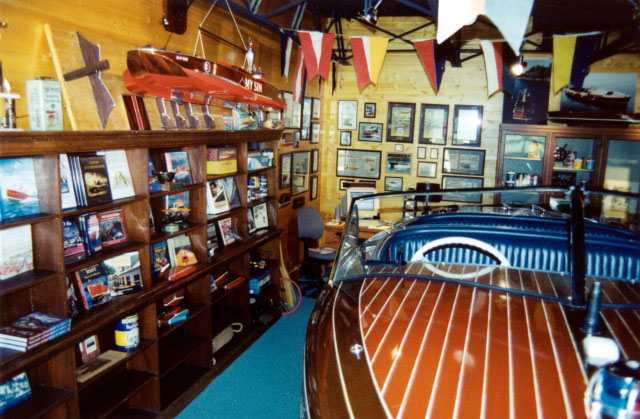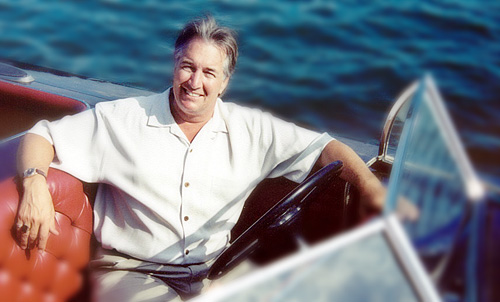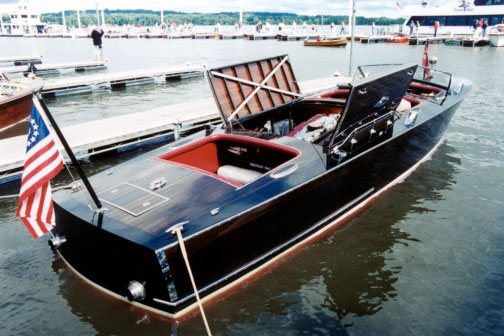“For Rome so near us, for the phoenix moment When we have thrown off this traveler’s trance And mother-naked and ageless ancient Wake in her warm nest of renaissance.” – Cecil Day-Lewis (1904-1972) Flight to Italy
Meet F. Todd Warner of Mound, Minnesota. He is a most interesting fellow. Hell… he’s downright fascinating. There is no one word or sentence to accurately describe him. To simply say that he is unique would be a gross understatement in fact. Genius?… in all likelihood. Knowledgeable?… exceptionally so. Passionate about boats?… intensely. Talented?… immensely. Professional?… Top Shelf. Tough?… as Rhino hide. Accomplished?… still counting. He is both a guardian of history and a maker of it. Old?… hardly.
In Plato’s Republic, Socrates (469-399 B.C.) reasons: “Our guardians ought not to be imitators, for one man can only do one thing well…” Todd is the genuine article but defies the predicate of the dictum. In the world and history of antique and classic boats, his vision, leadership and accomplishments rival those of Winston Churchill by the comparable age of forty-eight.
Born on March 20, 1953 in Hopkins, Minnesota, Todd was greatly influenced by his father, Frank Warner and, indirectly, by his grandfather, Harold Warner. Harold used to race Ramaley boats in the 1930s on nearby Lake Minnetonka. These boats were capable of speeds well in excess of sixty miles per hour and incorporated many unusual design features. Included is a cavernous interior, extremely high freeboard, incredibly artistic, sculptured curves in its sides, both forward and aft and an extremely innovative bottom design, referred to as a ‘rocker bottom’. The rocker bottom is the forerunner the modern-day tri-hull.
Harold Warner was apparently something of a character when it came to racing boats. The story goes that his Ramaley, Moona Hanas, was regularly defeated by the Chairman of Cream of Wheat – Dan Bull’s Ramaley, Roweda in their many encounters on Lake Minnetonka. In race after race, Mr. Bull would display his satisfaction in winning by articulating an incendiary gesture to Mr. Warner as he sped across the pre-determined finish line. This, of course, planted the seed of determination in Mr. Warner to, one day, repay the distinguished gentleman in-kind.
Prior to what would be one of, if not, their last race, Mr. Warner surreptitiously made a slight modification to Moona Hanas. He located and acquired a relatively unknown, and significantly larger aircraft engine called a Hispano-Suiza, which produced 365 horsepower. One of only seven built, the engine was massive for its day. With a little slick altering of the engine compartment, which included a cleverly hidden extension of the hatches, forward, along with minor alterations to the interior, the new power plant was installed.
The next race began as usual. Mr. Bull took the lead, as he anticipated he would. Mentally, he was preparing for the usual grand finale, which of course would include the now, infamous victory gesture upon crossing the finish line. However, at the appropriate calculated moment, Mr. Warner engaged his throttle to full-bore, passing Mr. Bull with ease to cross the finish line well ahead of him… ‘Going away’, as they say. Mr. Bull was nonplussed, to say the least. Especially so when Mr. Warner presented Mr. Bull with the identical, trademark gesture that he had endured from Mr. Bull for so many races.
In the 1938 Speed Boat Races in Wayzata, Minnesota (pronounced ‘Wy-zeta’), Harold Warner didn’t see the necessity of formally entering his boat in the races but decided to compete anyway. Much to the consternation of the registered participants, Mr. Warner assumed the starting position as, what may be politely described as a ‘wild card’ entrant. Defying the rules and protocol, Mr. Warner proceeded to win the race in a runaway victory… which, in his view, just happened to be an amusement on his way home.
Although Todd never knew his grandfather first-hand, he has learned a great deal about him over the years. In fact, in his extensive collection of rare boats from the past is the very same Ramaley that Harold Warner used to race on Minnetonka back in the ‘30s.
His father Frank, a statesmanlike, dashing and avant-garde gentleman was, and is, an avid sportsman and collector of what are now referred to as antique and classic boats. Among his present collection is a one-of-a-kind, 1930 30’ HackerCraft Limousine – Miss Janet, which made its first debut in 25 years at the 26th Annual Bob Speltz Land O Lakes Antique & Classic Boat Rendezvous this year in Red Wing. He also has In the late 1960s, companies such as Chris-Craft, Century and others gave in to the market demands of fiberglass and stopped producing wooden pleasure boats altogether. Frank viewed the transition as a buying opportunity. In what has been described as the First Great Harvest, Mr. Warner went about the business of collecting as many of the old woodies as he could get his hands on. The advent of fiberglass boats had, in effect, severely depressed the market for wooden boats. So much so that prices of the ‘now obsolete’ wooden models had dropped precipitously. They were available at bargain-basement levels and Mr. Warner seized the moment.
Among those harvested were a 19’ Chris-Craft Racing Runabout, the 1930 30’ Hacker Limousine, a ’55 Cobra, a 1959 26’ Riva Tritone, a 1937 27’ Triple Cockpit Chris-Craft Custom and many Centurys, GarWoods and Ventnors. The Harvest was not restricted to runabouts and included many inboard and outboard engines as well. Inboard engines ranged from Kermaths to Cadillacs and a substantial number of Chris-Crafts. Quantities of sailboats and rowboats were also caught in the net during the Harvest.
Growing up around Lake Minnetonka, surrounded by hundreds of wooden beauties to admire and experience, Todd Warner was a kid in a candy store. And, with such dedicated and enthusiastic iconic mentors, it doesn’t take a genius tofigure out which path young Todd would follow in life. By his early teens, he had become so exposed and immersed in the subject of wooden boats that he could readily recite much of the history of builders like Hacker, Gar Wood and Riva. He had caught the bug. It was contagious, infectious and incurable. Some might even refer to it as ‘boatitis’.
During his mid to late teens, Todd apprenticed at Tonka Bay Marine where he received formal training in the art and skill of restoring wooden boats. It would serve him well in later years. In his early twenties, he met another young boating enthusiast by the name of Robert G. Spletz (1943-1993). ‘Bob’ Speltz and Todd met at the Minneapolis Boat Show in 1976. At the time, Bob was in the process of compiling information for a book that he wanted to publish. It would be entitled The Real Runabouts. It was to be the first of seven encyclopedic accounts of the history of wooden boat builders ever produced. Todd eloquently contributed the Forward for the historic volume as well as substantial documentation for many segments of the book.
Though Speltz suffered from kidney disease and had to undergo dialysis three times a week, he didn’t let it interfere with, or dampen his enthusiasm for, his passion for the boats. He, like Todd, had grown up around them. His father had owned several wooden boats over the course of his life and Bob followed in his footsteps. His meeting with Todd would prove to be fortuitous.
By this time (mid ‘70s), Todd participated in the Second Great Harvest of wooden boats. His interest, knowledge and skills had risen to such a level that he decided to join his father in the business. Bob Speltz made arrangements to drive up from Albert Lea to visit with the 22 year-old prodigy and to write a story about him and his growing collection of boats. In the story, Bob reveals that upon launching his business in January, 1976, Todd was “very much in the boat business… actively selling, buying and restoring boats for his many customers.” The enterprise was called the Lake Minnetonka Restoration Company, which was part of Classic Runabout Corp. of America, founded by Todd in 1975.
Bob also reported that Todd had become a dealer and distributor for both Federal and Michigan propellers and was capable of custom building any shaft size to order. Furthermore, he had access to all of the pre-1965 Century hardware molds enabling him to produce any part a customer might want. Between Todd and his father, the collection of boats was rapidly growing into the hundreds. Also in the story, Speltz dubbed the young Industrialist “The Burt Reynolds of the Antique Boating World”. Now days, it might be more appropriate to refer to Todd as the “Don Johnson of the Antique Boating World” as he somewhat resembles the actor in appearance, style and fame.
The next couple of years were ambitious ones. In 1976 Todd became an Antique & Classic Boat Society (ACBS) Approved Judge. In that same year he became a Qualified Marine Surveyor. He had previously acquired a Captain’s and Engineering License for boats up to 55’ in length for Lake Minnetonka. In addition, he earned a similar license for boats to 70’ from the state of Iowa. In 1977, he founded the Land O Lakes Chapter of the ACBS, which was only the third chapter established at the time. He also served as it’s first president. The ACBS had been established two years earlier (1975) and in 1976, had less than 100 members nationally. As of 2001, the Land O Lakes Chapter is one of the largest and most active in the country with over 800 members.
Also in 1976, Todd initiated, planned and executed one of the earliest antique and classic boat shows in the U.S.: the Land O Lakes First Annual Antique & Classic Boat Rendezvous. It was an adjunct to his founding of the ACBS Chapter. Though the now famous boat shows in Clayton and Muskoka were known to have been held since the 1960s and early ‘70s, organized shows across the U.S. were few and far between. Todd was instrumental in breathing life into the new movement to save and preserve the heritage of wooden pleasure boats. Remarkably, he was only 23 years old at the time.
Over the next ten years, Todd continued to accumulate boats and amass information about them. His skills improved, his knowledge expanded and his collection of boats continued to grow. He is also, and has been, a major collector and curator of an ever-growing library of original, historical documentation on wooden boat builders from all over the world. His present library includes over 6,000 documents, brochures, photos, magazines, literature and research spanning the last century. It is one thing to be a collector and to be familiar with bits and pieces of the information acquired; it is quite another to be intimately familiar with the contents and details of such an expansive archive. But then, what else would you expect from someone who has personally owned over 1,000 vintage boats?
By 1986, Todd’s reputation and business had expanded to national proportions. His interests now included importing and selling fine English, German, Italian and American classic automobiles. To reflect the evolution into specializing in the best of the best, the name of the company was changed to
Bristol Classics, Ltd and was located in Excelsior, Minnesota. The boat restoration aspect of the business continued to grow along with a national renaissance of fine, wooden boats. As interest in owning vintage boats rose, so also did the necessity of providing quality workmanship in restoring them.
Bristol Classics’ reputation for exceptional work gained greater and greater fame in subsequent years. At the 1991 Concours d’ Elegance in Lake Tahoe, one of Todd’s restorations won ‘Best of Class’. High praise indeed. In order to win at Tahoe, the condition of the boat can be nothing less than exemplary. The quality of the work was so good that it was now justifiably referred to as ‘Award Winning’. The number of craftsmen in North America who specialize in the restoration of extremely rare and exotic boats at this level are as rare as the boats they work on.
Mahogany Bay’s Showroom
 Through the 1990s, restoration activities and sales continued to expand. Additional storage buildings and work facilities were added to address the increase in demand for quality boats and service. At the end of the decade, the company’s name was changed to a more reflective… Mahogany Bay. The business has evolved to include larger office and showroom facilities. The showroom certainly lives up to its name and is richly adorned with awards, trophies, plaques and historical memorabilia, in addition to a number of rare and diverse boats from the past.
Through the 1990s, restoration activities and sales continued to expand. Additional storage buildings and work facilities were added to address the increase in demand for quality boats and service. At the end of the decade, the company’s name was changed to a more reflective… Mahogany Bay. The business has evolved to include larger office and showroom facilities. The showroom certainly lives up to its name and is richly adorned with awards, trophies, plaques and historical memorabilia, in addition to a number of rare and diverse boats from the past.
Headquarters of Mahogany Bay is now located in Mound, Minnesota which is just a few miles west of Minneapolis and St. Paul. Between Mound and the Twin Cities are numerous storage facilities which house a multitude of rare boats. Viewing the contents of these buildings is like stepping through a portal in time. To the uninitiated, the vast collections in these cavernous dwellings might be mistaken for a gigantic time capsules that time has forgotten. Not so. In fact, they are enormous vaults filled with accumulated riches. They also serve as staging areas preparatory to their day of resurrection.
One of the great educational aspects of the tour is Todd’s encyclopedic knowledge of each boat and its respective historical significance. Regardless of the boat selected, there is a story to tell about it. As he rolls the cover back on one of the boats to expose its black-sided hull with sunken headlights in the bow, Todd immediately begins to explain its place in the world of vintage boats: “This is an Ancarrow, built in Richmond, Virginia in 1950 – 1960. It went to the London Palladium boat show… I bought it in England and shipped it home. Its one of only a very few in existence… this boat ate Cobras for breakfast… it has a 427 Ford in it…”
Or, he might point to one and say, “That’s a 1939 Goodhue Laker… built by Nat Goodhue. It was commissioned by J.C. Penney for his niece Laura Bushnell. It’s built of ¾” cedar over sawn oak frames… the hardware is commonly referred to as ‘German silver’. It has a high nickel content which gives it a beautiful champagne color. We had to fabricate the ventilators from the original drawings because they were no longer available… what makes the boat so special is the tremendous flare on the sides, the beautiful crown of its deck and the unique drop in the gunwales as you look aft…”
1929 30’ Triple Cockpit Dingle – Gerry Lo
One of the favorites in his collection is a 1929 30’ triple cockpit Dingle called the Gerry Lo. It is quite famous on Lake Minnetonka. Originally custom-designed by millionaire Frank Wolcott Griswold, the mahogany masterpiece was built by the Joseph Dingle Boatworks Company of St. Paul, Minnesota. Griswold, by his twenties, had already made millions with the Griswold Sign Company. His first major success was the ‘Bobby Sign’ which was the earliest version of the stoplight. He was nearly killed in a car accident in downtown Minneapolis in the 1920s and reportedly was overheard muttering, on the way to the hospital: “Someone ought to be able to invent a stop signal that would be visible in all kinds of weather.”


